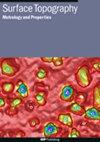Fabrication of superhydrophobic surface by a dimensional change in surface topography of microchannel on polymer substrate through induction-aided hot embossing: parametric investigation and optimization
IF 2
3区 材料科学
Q2 ENGINEERING, MECHANICAL
引用次数: 0
Abstract
Abstract Hot embossing (HE) is a micro-fabrication technique employed to create micron-scale patterns on the polymer substrate. An in-house induction-assisted hot embossing (IHE) setup was fabricated to complete the embossing in a short duration as compared to traditional hot embossing process. This work alters the polymer surface topography to make it superhydrophobic for self-cleaning. Fiber laser machining was used to produce four-microchannel designs on an Aluminum-6061 plate in which the microchannel width was varied from 600 μ m to 150 μ m while maintaining a constant adjacent distance of 300 μ m. This textured plate is employed as a mold in the IHE setup. IHE process parameters, embossing temperature, pressure, time, and deembossing temperature were varied to emboss the mold designs on a polyethylene terephthalate substrate. Thereafter, the embossed microchannel height, surface roughness, and water contact angle perpendicular to the embossed microchannels (WCA ⟂ ) were calculated. The parametric analysis examined how operational factors affected the output. The experiment was done as per the central composite design (experimental design) part of the design-of-experiments useful in the response surface model. Parametric research demonstrates that embossed microchannel height and width had a maximum effect on WCA ⟂ . Type-IV microchannels with 150 μ m width demonstrated the highest WCA ⟂ . The WCA ⟂ was mostly impacted by embossed microchannel height; hence a regression model was created using type-IV channel height data. Analysis of variance showed that embossing temperature mainly impacts microchannel height. The recently invented Jaya-algorithm optimized this model to increase embossed microchannel height and WCA ⟂ . Setting the parameters at the best level predicted by Jaya-algorithm yielded an embossed microchannel height inaccuracy of 2.18%. The WCA ⟂ measured on the surface of a sample prepared at the best parameters was found to be 154.71°感应辅助热压法制备聚合物基板微通道表面形貌尺寸变化的超疏水表面:参数研究与优化
摘要热压印(HE)是一种用于在聚合物基板上形成微米尺度图案的微加工技术。与传统的热压印工艺相比,制作了一个内部感应辅助热压印(IHE)装置,以在短时间内完成压印。这项工作改变了聚合物的表面形貌,使其具有自清洁的超疏水性。采用光纤激光加工技术在铝-6061板上加工出宽度为600 ~ 150 μ m、相邻距离为300 μ m的4个微通道设计,并将该纹理板作为IHE装置的模具。通过改变压印温度、压力、时间和去压印温度,将模具设计压印在聚对苯二甲酸乙二醇酯基板上。然后,计算压纹微通道的高度、表面粗糙度和垂直于压纹微通道的水接触角(WCA⟂)。参数分析考察了操作因素对产量的影响。实验是按照响应面模型中有用的实验设计的中心复合设计(实验设计)部分进行的。参数化研究表明,压花微通道高度和宽度对WCA的影响最大⟂。宽度为150 μ m的iv型微通道WCA最高⟂。WCA⟂主要受压纹微通道高度的影响;因此,使用iv型通道高度数据创建了回归模型。方差分析表明,压花温度主要影响微通道高度。最近发明的jaya算法优化了该模型,增加了浮雕微通道的高度和WCA⟂。将参数设置在jaya算法预测的最佳水平上,浮雕微通道高度误差为2.18%。在最佳参数下制备的样品表面测量的WCA⟂为154.71°±2°。最后,FTIR(傅里叶变换红外光谱)测试表明,压印样品和裸样品的化学成分没有变化。
本文章由计算机程序翻译,如有差异,请以英文原文为准。
求助全文
约1分钟内获得全文
求助全文
来源期刊

Surface Topography: Metrology and Properties
Materials Science-Materials Chemistry
CiteScore
4.10
自引率
22.20%
发文量
183
期刊介绍:
An international forum for academics, industrialists and engineers to publish the latest research in surface topography measurement and characterisation, instrumentation development and the properties of surfaces.
 求助内容:
求助内容: 应助结果提醒方式:
应助结果提醒方式:


